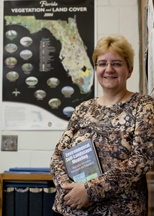Warm temperatures and a wet landscape increase soil’s ability to store carbon, which in turn helps mitigate greenhouse gas emissions, according to a new University of Florida study covering 45 years of data.
Soil-stored carbon can slow the build-up of carbon-based gases in the atmosphere, a phenomenon believed to be a cause of global climate change. So it’s vital to preserve soil carbon, said Sabine Grunwald, a UF soil and water science professor who led the research.
“The conservation of the ‘black gold’ below our feet, which is not only a natural part of Florida’s soils but also helps to improve our climate and agricultural production, is a hidden treasure,” said Grunwald, a member of the Institute of Food and Agricultural Sciences faculty. “Soils serve as a natural container to hold carbon that would otherwise be emitted into the atmosphere as greenhouse gases that accelerate global climate change.”
In addition to environmental stewardship, landowners can make money by storing carbon. Participants in the state’s Florida Stewardship Program are sitting on an estimated $300 million worth of carbon.
Because it’s so wet, Florida’s soil has historically stored more carbon than any state, except perhaps Alaska, which has not been studied extensively, Grunwald said.
With Florida’s rapid population growth in the past 45 years, from 5 million to about 18 million, land use has changed considerably. More urban areas have sprung up, while agricultural, rangeland and forests have declined, Grunwald said. That change has caused carbon-rich wetlands to increase 140 percent, while carbon-poor agricultural land decreased about 20 percent, according to the study.

In the first study of its kind, UF researchers reviewed data from 1,251 soil samples collected across Florida from 1965 to 1996. They also collected 1,080 new soil samples statewide in 2010. They studied carbon sequestration rates from 1965 to 2010.
Researchers studied land use, land cover and climate change to see how those factors affect the soil’s ability to store carbon. Organic carbon in soil includes dead plant and animal tissue and makes up most global soil carbon.
Land cover is what’s on the Earth’s surface, whether it’s dirt, pavement, water or trees, among other things. Land use means how people utilize public and private land, such as agriculture, forestry or conservation land.
Together, land use, land cover and climate change account for 46 percent of soil carbon sequestration, the study showed. Of that, land use and land cover account for 27 percent, while climate change account for 19 percent.
Researchers used temperature and rain to determine the effect of climate change. They found higher average annual temperatures correlated with higher soil carbon sequestration, specifically in crops, mesic upland forest, pineland and land converted from pine forests to urban use. Areas with higher average annual precipitation showed less sequestration in agricultural crops and pine forests.
Among land-use types, researchers also found sugarcane in the soils of the Everglades Agricultural area near Lake Okeechobee and wetlands stored the most soil carbon while crop, citrus and relatively dry upland forest sequestered the least.
Results of the study appear in the September issue of the journal Science of the Total Environment.
Historically, Florida soils stored the largest amount of soil organic carbon (SOC) among the conterminous U.S. states (2.26 Pg). This region experienced rapid land use/land cover (LULC) shifts and climate change in the past decades. The effects of these changes on SOC sequestration are unknown.
The objectives of this study were to 1) investigate the change in SOC stocks in Florida to determine if soils have acted as a net sink or net source for carbon (C) over the past four decades and 2) identify the concomitant effects of LULC, LULC change, and climate on the SOC change. A total of 1080 sites were sampled in the topsoil (0–20 cm) between 2008 and 2009 representing the current SOC stocks, 194 of which were selected to collocate with historical sites (n = 1251) from the Florida Soil Characterization Database (1965–1996) for direct comparison.
Results show that SOC stocks significantly differed among LULC classes – sugarcane and wetland contained the highest SOC, followed by improved pasture, urban, mesic upland forest, rangeland, and pineland while crop, citrus and xeric upland forest remained the lowest. The surface 20 cm soils acted as a net sink for C with the median SOC significantly increasing from 2.69 to 3.40 kg m− 2 over the past decades. The SOC sequestration rate was LULC dependent and controlled by climate factors interacting with LULC. Higher temperature tended to accelerate SOC accumulation, while higher precipitation reduced the SOC sequestration rate. Land use/land cover change observed over the past four decades also favored the C sequestration in soils due to the increase in the C-rich wetland area by ~ 140% and decrease in the C-poor agricultural area by ~ 20%. Soils are likely to provide a substantial soil C sink considering the climate and LULC projections for this region.
Interaction effects of climate and land use/land cover change on soil organic carbon sequestration by Xiong Xiong, Sabine Grunwald, D. Brenton Myers, C. Wade Ross, Willie G. Harris, Nicolas B. Comerford published in Science of The Total Environment Volume 493, 15 September 2014, Pages 974–982
Read the abstract and get the paper here.
News release issued by Institute of Food and Agricultural Sciences and University of Florida here.
